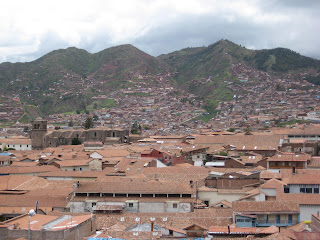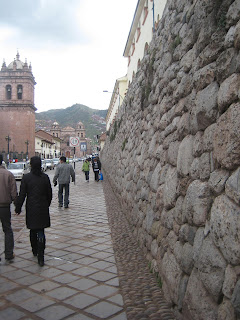After my Peruvian adventures I flew to Santiago, Chile for a week of sunshine and rest. Chile is beautiful. The minute I stepped out of the airport I knew I would like it here. It is beautiful, modern, peaceful, cleaner and what a great vibe!
On the plane as I flew over the Andes, I read the book "Miracle In The Andes" about the Uruguayan soccer team that crashed their plane on the way to Chile. You may know the story from the movie "Alive". The book is written by one of the survivors - Nando Parado. At first I was a bit leery about reading of a plane crash while I was flying over that very same location. However, they were in a small private plane that had to fly through the mountains - I had a big plane that went over the mountains! I was bawling like a baby in the airport, on the plane, in the line-up for customs. I highly recommend this book as I appreciated Nando's perspective on the meaning of life. I was deeply affected by what they went through. Thanks Regan - this book was a fantastic recommendation.
 |
| Sunset over Santiago (brought to you by LAN Flight 093) |
Santiago is nestled at the base of the Andes mountains, and San Cristobal Hill and the Metropolitan Park were 10 minutes from my hotel. This hill gives you an amazing view of the entire city, and the mountains. It was quite hazy but I could still see the outline of the mountains - what a gorgeous view.
 |
| View from San Cristobal Hill. |
I approached a section of the park that I assumed was a children's playground. It turns out - it was an adult playground. Instead of slides and swings - the park had workout equipment. It was so much fun to workout under the sun!!
 |
| Elliptical Trainer. |
 |
| And membership is free! |
I visited a park that has over 35 sculptures. I had fun trying to interpret what the artists put together.
 |
| Dancing birds??? |
 |
| Ummm...what's the Spanish word for...? |
A beautiful water fountain was along the main street to the park. I would often sit here and read (and people watch).
I rode the Funicular up San Cristobal Hill to the "Sanctuario Immaculada Conception" and the big statue of the Virgin Mary. I found irony in seeing a huge religious statue with an even bigger cell phone tower next to it. Kind of ruins the view. I guess when you are done praying you can phone your mom.
 |
| Statue of the Virgin Mary. |
 |
| "Hello? Are you there God? It's me...Zanner." |
Most days were heavenly and hot (probably high 30s, could have even been in the 40s!) and the sky was a perfect blue. The weather here is amazing. It's very hot but there is a lot of shade (big trees everywhere) and there always seems to be a cool breeze. It's very dry which makes it a nice combination. The sky is a crystal clear blue - everyday! I didn't seen one cloud in the entire week. The sun stays out until 9pm so the evenings are wonderful for eating and drinking on a patio. There are no bugs to bother you - it's quite relaxing. I got emotional on the hill just thinking how lucky I am to be in Santiago with the perfect weather. It's snowing and cold in Canada - and I heard that even Dallas and Houston have snow. I would definitely come back to Santiago.
 |
| Sunset in Providencia, Santiago |
I stayed at "Meridiano Sur Petit Hotel". They have converted an old house into an 8 bedroom hotel. My room was really small but the guests can use the patio and the livingroom. It's like being at a house - the livingroom has books, DVDs, a stereo and computers for those who don't have laptops.
 |
| Meridiano Sur Petit Hotel in Providencia, Santiago. |
My little hotel has poetry on the walls, and I really like the poem along the staircase that guided me to my room:
Thanks to Life by Violeta Parra
Thanks to life, which has given me so much. It has given me two eyes, and when I open them I clearly distinguish black from white. And in the high sky, its starry depths, and from the crowds, the man that I love.
Thanks to life, which has given me so much. It has given me hearing, which in all its breadth, day and night records cricket and canaries, hammers, turbines, barking, dark clouds, and the tender voice of my beloved one.







































